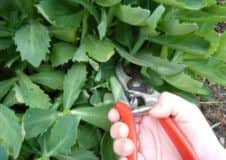Time to brandish those secateurs in the garden


You always think about pruning shrubs and pruning perennials down at the end of the year, but pruning perennials mid-season is a great way to get flowers on a more compact stem plus later on. You can’t do it with all perennials; you need a stem with alternate leaves all the way up like Border Phlox and Heleniums. Plants like Geraniums and Astrantias, with leaves coming from the base, will not respond the same.
It is called the “Chelsea Chop” because this is the time to do it in relation to Chelsea Flower Show. However, in a late year like last year it becomes more like early June. The pruning is simple; just take the secateurs to the clump, cutting it back by half, subsequently reducing the growth rate because at this time of year plant growth explodes.
Advertisement
Hide AdAdvertisement
Hide AdIt can only be those plants with leaves all the way up the stems as it is these leaves that have dormant buds tucked away in the node (leaf joint) and the removal of the growth tip stops auxins being produced. Auxins tell the plant to get as big as it can and reduce any lateral growth. Their removal causes a surge of growth lower down, resulting in a compact plant.


The plant will also still flower, but later on as it needs time to adjust. The key thing with the Chelsea Chop is to also make sure your plants are fed. Either give a feed with tomato feed to give a short sharp burst of potash, or use Vitax Q4 sprinkled around the base to give more a prolonged feed. This then ensures the plant has the energy to produce not just one flower but up to four flowers for each removed stem!
If you plan it cleverly you can really make the Chelsea Chop work for you. After time you may have the same variety of say Phlox in a few parts of the garden. Leave some clumps to flower normally and cut others back by half now. This way the untouched ones will flower like normal, then when they’ve finished the cut back ones will start. This way instead of four weeks of colour you will have eight!
So give it a go, but remember, make sure it’s a plant with alternate leaves all the way up the stems (Monardas, Phlox, Helenium, Helianthus, Veronicastrums, Sedums etc.) and make sure it’s got the food to give it the energy to grow a new head in a matter of weeks!